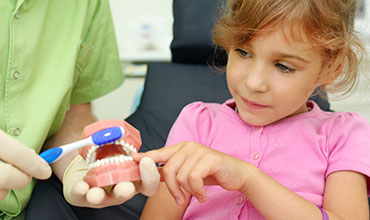
Start dental visits during infancy
The American Academy of Pediatric Dentistry recommends bringing your child to the dentist before his or her first birthday. At this initial visit, Reynolds Dentistry will:
Children should see a dentist every six months. To help your child develop a positive attitude about the dentist:
Cleaning a child's teeth should begin when the first tooth is visible, because teeth are susceptible to decay as soon as they appear in the mouth.
Wipe the baby's teeth and gums clean after every feeding with a soft, damp washcloth or gauze pad. A leading cause of tooth decay among young children is known as "baby bottle syndrome." When an infant is allowed to drink from a nursing bottle containing milk, formula or fruit juice during nap time or at night, the baby often falls asleep with the bottle in his or her mouth. Exposure to the sugars and acids in these liquids that pool around the teeth can cause discoloration and decay.
Since breast milk contains sugar, decay also can occur when a baby falls asleep while breast-feeding. To prevent damage to the teeth, clean your child's teeth after each feeding and, if necessary, give him or her a bottle filled only with water at bedtime or during a nap.
Studies have shown that children who drink fluoridated water from birth have up to 65 percent fewer cavities, and by the time they become teenagers, many of them still have no tooth decay.
If you live in a community without a fluoridated water supply, you can make sure your kids get their fluoride by using tablets, drops or gel and by having topical fluoride treatments applied at the dental office (to check whether your drinking water contains fluoride, call your local water company or health department). Using a fluoride toothpaste and mouth rinse is also effective.
A balanced diet is also an important contributor to healthy teeth and gums. Children especially need calcium, which helps build strong teeth. Good sources of calcium are milk, cheese and yogurt. Research shows that eating cheese after meals seems to inhibit the effects of decay-causing acids. Avoid snacks containing sugar or starch.
Children should be brushing their own teeth under adult supervision. Only a pea-sized amount of toothpaste is necessary. Start flossing your child's teeth daily when all the primary teeth are in or when teeth are touching each other.
Children should be able to brush and floss by themselves, with occasional checks. Turn brushing and flossing into a daily routine — make it fun by giving your child a colorful toothbrush and bubble gum-flavored floss.
With a parent’s guidance and proper personal and professional care, children have a good foundation for maintaining healthy teeth.